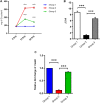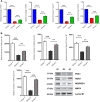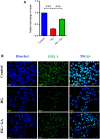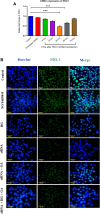Gymnemic Acid Ameliorates Pancreatic β-Cell Dysfunction by Modulating Pdx1 Expression: A Possible Strategy for β-Cell Regeneration
- PMID: 35212973
- PMCID: PMC9130387
- DOI: 10.1007/s13770-022-00435-7
Gymnemic Acid Ameliorates Pancreatic β-Cell Dysfunction by Modulating Pdx1 Expression: A Possible Strategy for β-Cell Regeneration
Abstract
Background: Endogenous pancreatic β-cell regeneration is a promising therapeutic approach for enhancing β-cell function and neogenesis in diabetes. Various findings have reported that regeneration might occur via stimulating β-cell proliferation, neogenesis, or conversion from other pancreatic cells to β-like cells. Although the current scenario illustrates numerous therapeutic strategies and approaches that concern endogenous β-cell regeneration, all of them have not been successful to a greater extent because of cost effectiveness, availability of suitable donors and rejection in case of transplantation, or lack of scientific evidence for many phytochemicals derived from plants that have been employed in traditional medicine. Therefore, the present study aims to investigate the effect of gymnemic acid (GA) on β-cell regeneration in streptozotocin-induced type 1 diabetic rats and high glucose exposed RIN5-F cells.
Methods: The study involves histopathological and immunohistochemical analysis to examine the islet's architecture. Quantitative polymerase chain reaction (qPCR) and/or immunoblot were employed to quantify the β-cell regeneration markers and cell cycle proliferative markers.
Results: The immunoexpression of E-cadherin, β-catenin, and phosphoinositide 3-kinases/protein kinase B were significantly increased in GA-treated diabetic rats. On the other hand, treatment with GA upregulated the pancreatic regenerative transcription factor viz. pancreatic duodenal homeobox 1, Neurogenin 3, MafA, NeuroD1, and β-cells proliferative markers such as CDK4, and Cyclin D1, with a simultaneous downregulation of the forkhead box O, glycogen synthase kinase-3, and p21cip1 in diabetic treated rats. Adding to this, we noticed increased nuclear localization of Pdx1 in GA treated high glucose exposed RIN5-F cells.
Conclusion: Our results suggested that GA acts as a potential therapeutic candidate for endogenous β-cell regeneration in treating type 1 diabetes.
Keywords: Diabetes; Gymnemic acid; Islet architecture; β-Cell proliferation; β-Cell regeneration.
© 2022. The Korean Tissue Engineering and Regenerative Medicine Society.
Conflict of interest statement
The authors declare that they have no conflict of interest.
Figures






Similar articles
-
Garlic Extract Promotes Pancreatic Islet Neogenesis Through α-to-β-Cell Transdifferentiation and Normalizes Glucose Homeostasis in Diabetic Rats.Mol Nutr Food Res. 2024 Oct;68(19):e2400362. doi: 10.1002/mnfr.202400362. Epub 2024 Aug 29. Mol Nutr Food Res. 2024. PMID: 39205537
-
Dapagliflozin promotes beta cell regeneration by inducing pancreatic endocrine cell phenotype conversion in type 2 diabetic mice.Metabolism. 2020 Oct;111:154324. doi: 10.1016/j.metabol.2020.154324. Epub 2020 Jul 23. Metabolism. 2020. PMID: 32712220
-
Gymnemic acid protects murine pancreatic β-cells by moderating hyperglycemic stress-induced inflammation and apoptosis in type 1 diabetic rats.J Biochem Mol Toxicol. 2022 Jul;36(7):e23050. doi: 10.1002/jbt.23050. Epub 2022 Mar 27. J Biochem Mol Toxicol. 2022. PMID: 35343011
-
PDX1, Neurogenin-3, and MAFA: critical transcription regulators for beta cell development and regeneration.Stem Cell Res Ther. 2017 Nov 2;8(1):240. doi: 10.1186/s13287-017-0694-z. Stem Cell Res Ther. 2017. PMID: 29096722 Free PMC article. Review.
-
Pharmacological treatment of chronic diabetes by stimulating pancreatic beta-cell regeneration with systemic co-administration of EGF and gastrin.Pharmacol Toxicol. 2002 Dec;91(6):414-20. doi: 10.1034/j.1600-0773.2002.910621.x. Pharmacol Toxicol. 2002. PMID: 12688387 Review.
Cited by
-
Genetic and pharmacologic inhibition of ALDH1A3 as a treatment of β-cell failure.Nat Commun. 2023 Feb 2;14(1):558. doi: 10.1038/s41467-023-36315-4. Nat Commun. 2023. PMID: 36732513 Free PMC article.
-
Targeting β-Cell Plasticity: A Promising Approach for Diabetes Treatment.Curr Issues Mol Biol. 2024 Jul 18;46(7):7621-7667. doi: 10.3390/cimb46070453. Curr Issues Mol Biol. 2024. PMID: 39057094 Free PMC article. Review.
-
PDX-1: A Promising Therapeutic Target to Reverse Diabetes.Biomolecules. 2022 Nov 30;12(12):1785. doi: 10.3390/biom12121785. Biomolecules. 2022. PMID: 36551213 Free PMC article. Review.
-
Regeneration of Pancreatic Beta Cells by Modulation of Molecular Targets Using Plant-Derived Compounds: Pharmacological Mechanisms and Clinical Potential.Curr Issues Mol Biol. 2023 Jul 26;45(8):6216-6245. doi: 10.3390/cimb45080392. Curr Issues Mol Biol. 2023. PMID: 37623211 Free PMC article. Review.
References
-
- Richardson T, Kerr D. Skin-related complications of insulin therapy: epidemiology and emerging management strategies. Am J Clin Dermatol. 2003;4:661–7. - PubMed
Publication types
MeSH terms
Substances
LinkOut - more resources
Full Text Sources
Research Materials
